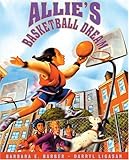Lesson 1: Realistic Fiction
Lesson Plan
Allie's Basketball Dream | 450L

- Learning Goal
- Identify the characteristics of realistic fiction.
- Duration
- Approximately 50 minutes
- Necessary Materials
- Provided: Direct Teaching Example Chart
Not Provided: Allie’s Basketball Dream by Barbara E. Barber, chart paper, markers, fiction books from classroom library
-
Teacher Modeling

will provide a definition of realistic fiction (The events in the story could happen, but did not). I will chart the definition of realistic fiction and some of the characteristics of the genre. (Direct Teaching Example Chart provided below in Teacher and Student Materials.) I will tell two stories about our class. The first will be a fantasy story that takes place in the classroom but is about a student flying across the room. The second is a realistic fiction story that takes place in the classroom, but is about an argument between two students. I will discuss how the first story could not have happened; the second story could have happened, but didn’t. Although it is a fiction story, it is realistic.
-
Think Check
Ask: How did I know that the second story I told was an example of realistic fiction? Students should respond that you thought about whether the story was possible or impossible. You also thought about if the story was true—it really happened—or made up.
-
Guided Practice

will read Allie’s Basketball Dream by Barbara E. Barber and discuss whether the events from the story are realistic. We will stop every 2–3 pages to discuss whether the events are realistic. For example, a father giving his daughter a basketball as a gift could happen. It is realistic.
-
Independent Practice

will choose one realistic fiction book from the classroom library. You will identify the characteristics of the book that tell you it is realistic fiction.
Texts & Materials
Standards Alignment
(To see all of the ReadWorks lessons aligned to your standards, click here.)


I love this lesson!
Great Lesson